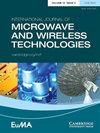神经网络辅助液晶微波相控阵天线的快速相位校准方法
IF 1.3
4区 计算机科学
Q3 ENGINEERING, ELECTRICAL & ELECTRONIC
International Journal of Microwave and Wireless Technologies
Pub Date : 2024-08-13
DOI:10.1017/s175907872400014x
引用次数: 0
摘要
液晶微波相控阵(LC-MPA)因其在成本、尺寸、重量和功耗方面的优势,被视为实现紧凑型天线的理想方法。然而,低辐射偏转效率一直是 LC-MPA 的主要应用限制之一。为了优化 LC-MPA 的转向性能,必须建立信道缺陷模型并补偿相位误差。本文通过训练神经网络来建立相位误差估计模型,在近场相位误差和远场模式之间建立非线性关系,从而在多个测量模式内实现 LC-MPA 的快速校准。为了验证这种方法,我们在一个 64 信道的二维平面天线上进行了模拟和实验。结果表明,该方法可提供平均 3.58° 的精确相位误差估计,实现了多个现场测量辐射模式的快速校准过程,并在不同转向角下将 LC-MPA 的偏转效率提高了约 4%-10%。本文章由计算机程序翻译,如有差异,请以英文原文为准。
A fast phase calibration method for a liquid crystal microwave phased array antenna assisted by neural network
Liquid crystal microwave phased arrays (LC-MPAs) are regarded as an ideal approach to realize compact antennas owing to their advantages in cost, size, weight, and power consumption. However, the shortcoming in low radiation deflection efficiency has been one of LC-MPAs’ main application limitations. To optimize the steering performance of LC-MPAs, it is essential to model the channel imperfections and compensate for the phase errors. In this paper, a phase error estimation model is built by training a neural network to establish a nonlinear relationship between the near-field phase error and the far-field pattern, hence realizing fast calibration for LC-MPAs within several measured patterns. Simulations and experiments on a 64-channel, two-dimensional planar antenna were conducted to validate this method. The results show that this method offers precise phase error estimations of 3.58° on average, realizes a fast calibration process with several field-measured radiation patterns, and improves the performances of the LC-MPA by approximately 4%–10% in deflection efficiency at different steering angles.
求助全文
通过发布文献求助,成功后即可免费获取论文全文。
去求助
来源期刊

International Journal of Microwave and Wireless Technologies
ENGINEERING, ELECTRICAL & ELECTRONIC-TELECOMMUNICATIONS
CiteScore
3.50
自引率
7.10%
发文量
130
审稿时长
6-12 weeks
期刊介绍:
The prime objective of the International Journal of Microwave and Wireless Technologies is to enhance the communication between microwave engineers throughout the world. It is therefore interdisciplinary and application oriented, providing a platform for the microwave industry. Coverage includes: applied electromagnetic field theory (antennas, transmission lines and waveguides), components (passive structures and semiconductor device technologies), analogue and mixed-signal circuits, systems, optical-microwave interactions, electromagnetic compatibility, industrial applications, biological effects and medical applications.
 求助内容:
求助内容: 应助结果提醒方式:
应助结果提醒方式:


